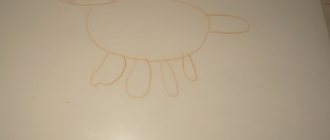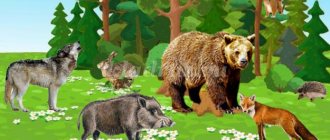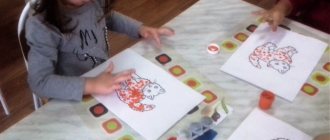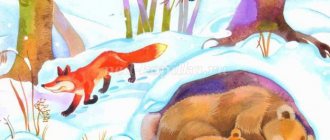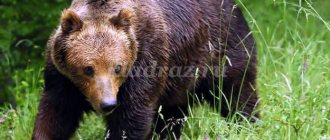GAMES AND TRAININGS FOR FORMING SYSTEMIC THINKING IN CHILDREN “TRIZ”
"What happened? What will happen"
For the game you will need pictures of well-known fairy tales. You can use not only illustrations, but also schematic “frames” for the plot, drawn together with the children. Everyone receives one picture and, upon a signal, must quickly take their place in the general line. Then there is a discussion: each child names what is shown in the picture, whether it was in the plot or will still be (in relation to the previous performance). For example, Kolobok met a hare and sings him a song. It is now. Kolobok runs away from home. It was. The gingerbread man sits on the fox's nose. It will be.
Building a supersystem and subsystem of connections. Highlighting properties.
"Magic bag"
Several objects or toys are placed in a bag made of opaque material. The called child puts his hand into the bag, feels the object and aloud lists the properties that tactile sensations tell him. The rest of the children guess this object based on the listed properties. It is advisable that the bag contains no more than 5 - 6 objects made from different materials and not having clearly defined parts, since instead of properties, the child can name the parts of the object and the answer will be obvious.
"You are my piece"
Children sit in a circle. One of them names the image, and the rest name its parts: I am the machine, and you are my piece. I am your steering wheel, wheel, headlight, etc. As a complication, it is proposed to build a whole subsystem chain: I am the machine, and you are my piece. I am your headlight, and you are my piece. I am a light bulb in a headlight, and you are my piece, etc.
"Guess - ka"
The child makes an image for himself and describes it without naming it. The rest must guess from the description who the child wished for. It is allowed to introduce a condition: instead of describing the properties, the child can name several supersystems of the object (I am in the forest, in a cage, in a zoo, etc.). Then, when guessing, children can ask several clarifying questions that can only be answered with yes or no.
“Something is part of something”
The principle of this game is taken from a game TV show. You will need a cut subject picture of 12-16 parts. The picture lies face down on the table. At random, at the request of the children, one square is opened. Children look at it, guess what the image looks like, what other objects have such parts. When the options are exhausted, the next square is opened. And so on until what is shown in the picture is guessed.
"Let's go for a ride"
Each child receives a medallion with a picture of some object. In different corners of the room using a picture or object. Children move like a train around the room. Near the station a signal is given: “We have arrived!” The teacher announces the name of the station by class (station of dishes, transport), by material (station of wooden products), by property (station of such and such a color), etc. Depending on the named sign, children decide whether to go out or not. Those who came out must justify their decision.
TRIZ games for preschoolers, part 2
It is with pleasure that I continue to talk about the TRIZ games that I use in my classes with children. Why these games are useful and how to play them can be read here.
Thanks to I.N. Muraszkowska, S.A. Gin, T.A. Sidorchuk, I.Ya. Gutkovich and many other authors for the opportunity to tell you about these games.
“Tease” (from 5 years old).
For what
: We learn to determine the main function of an object (later this will be very useful in TRIZ), we develop speech.
Props
: You can prepare subject pictures, or you can do without them. If you want dynamism, then you can play with the ball.
Reminder
: Of course, you can tease someone to offend, but why? We'd rather be kind teasers who come up with funny rather than offensive nicknames.
Let's play!
The presenter shows or names the object. Children imitate him using suffixes: -lka, -chk, -shche, etc.
- Cat. - Meow, runner, biter, meow, sonechka... - Ball. - Jumper, toy, breaker, roller.
- Snow. - Cover, blanket, insulation, warmer. - When can he be a hider? - When there is a lot of it, it covers the earth and retains heat.
“Who are my friends” (from 4 years old).
For what
: We develop systems thinking, learn to find analogies.
Props
: Younger children can be offered a ready-made set of pictures to choose from; older children will come up with everything themselves without prompting. The game is mobile, it is better to play it where space allows you to run.
Reminder
: remember what features objects can be similar to - color, shape, size, purpose, parts, etc.
Let's play!
The adult leader moves away from the players as far as possible and from his place names the object into which he has turned. Then the presenter says the words: “One, two, three! Who is my friend based on (insert the desired characteristic), run to me!” Children run up to the leader and name who they have become.
Note: If the children are small, then many small cards depicting objects can be placed next to them.
Q: I am the ball. My friends are all round objects. One two Three! Who is my friend, run to me!
D: I am a round ball, I am a round watermelon, I am a round plate...
Q: I am a helicopter. My friends are everything that can fly. One two Three! Who is my friend, run to me!
D: I am a bird, I am a leaf, I am an airplane, I am a rocket...
Game “Little Red Riding Hood” (from 5 years old)
For what
: Developing creative imagination
Props
: Paper and markers.
Reminder
: We remember the story about Little Red Riding Hood, especially the moment when the wolf eats the grandmothers and how it ended in the end.
Let's play!
We want the grandmother to be saved from the teeth of the wolf in this fairy tale, and the wolf himself does not want to eat the grandmother. This is the ideal end result. Let's play this episode in a modified form: the grandmother, realizing that there is a wolf in front of her, turns into some object in order to avoid a sad fate.
We offer the children an object that the grandmother has turned into (for example, a glass, a window, a boot, a candle, etc.), and ask them to name the properties of this object (a glass - hard, transparent, glass). Then the adult draws a grandmother who has turned into this object (that is, a glass with the grandmother’s head, arms and legs, don’t forget the scarf on her head!) We appoint someone as Little Red Riding Hood and conduct a dialogue:
- Grandma, grandma, why are you so... (call one of the properties, for example, hard)?
The rest answer why grandmother needs such a property and how it can help her protect herself from the wolf.
“I’m so hard for strength, and a wolf can break his teeth on me.”
Next time I’ll tell you about games that have successfully migrated from the category of preschool to the category of games for all ages.
To be continued!
LiveJournal
preschoolers, Games, development of thinking
You may also be interested in: New TRIZ games for developing thinking
Drawing without a brush
Awaken creativity: 19 practices and exercises for adults
TRIZ games for preschoolers, part 3
Interpretation of the “Non-existent animal” test
Test indicators (indicators of psychomotor tone)
Weak pressure – asthenia; passivity; sometimes a depressive state. Strong pressure – emotional tension; rigidity [1] ; impulsiveness. Extra-strong pressure (pencil tears paper) – conflict; hyperactivity; sometimes aggressiveness, acute agitation.
Features of lines
Dashed lines – anxiety as a personality trait. Multiple lines – anxiety as a state at the time of examination; stressful state; sometimes impulsive. Sketch lines - the desire to control your anxiety, to control yourself. Missing lines that do not hit the right point - impulsiveness; organic brain damage. Lines that are not completed are asthenia, sometimes impulsivity. Distortion of the shape of lines – organic brain damage; impulsiveness; sometimes mental illness.
Size of the picture and its location
Increased size – anxiety, stress. Reduced size – depression, low self-esteem. The drawing is shifted upward or located in the upper half of the sheet, but not in the corner - sometimes inflated self-esteem; desire for high achievements. The picture is shifted downwards - sometimes reduced self-esteem. The pattern is shifted to the side - sometimes organic brain damage. The drawing goes beyond the edge of the sheet - impulsiveness; acute anxiety. The picture is placed in the corner - depression.
Type of animal in the “Non-existent animal” technique
Based on the typology of images of non-existent animals, we can note the most common of them.
1. The subject depicts a real-life animal and calls it by a real name, and the description of its lifestyle corresponds to reality. For example, a cat is drawn and the cat’s lifestyle is described. Such an image may be considered the norm for a five- to six-year-old child, but for teenagers and adults it may indicate a low level of imagination.
2. An extinct animal that once existed is drawn, for example a dinosaur, mammoth, etc.
3. Draw an image of an animal that exists in culture, but does not exist in nature, for example, a dragon, mermaid, etc. Drawings depicting extinct animals, as well as drawings depicting existing ones in culture, are the norm for children 8–9 years old. For adults, such a drawing of an animal indicates his low general cultural level and poverty of imagination.
4. A drawing of a non-existent animal is usually constructed from parts of different real animals: the body of a crocodile, the limbs of a monkey, the head of a hare, etc. Such an animal may have, for example, the name Krokozai. Such an image of an animal is more typical of rationalists rather than creative people.
5. Sometimes the image of animals has a humanoid appearance. This indicates a strong need for communication, which is usually characteristic of teenagers - 13-17 years old.
6.The animal depicted consists of various mechanical parts. Such an animal is usually depicted by people with unconventional thinking and approach to life.
7. An intricate, complex and original image of an animal, the image of which has not a composite, but an integral structure, with a difficult or unidentifiable resemblance to any really existing (existing) animal, is characteristic of a person with a well-developed, rich creative imagination.
TRIZ games for children: developing systems thinking
Interesting games are loved not only by children, but also by adults. Especially if to carry them out you don’t have to rummage through closets looking for the right part, buy expensive plastic characters and create the illusion of interest. This is why I love TRIZ: for its simplicity, accessibility, variability, and especially for myself in these games - inspired, inquisitive, omniscient, sometimes cunning, inventive and lively.
Games based on the theory of solving inventive problems help me achieve my main goal - to live in joy always and everywhere. Unfortunately, the mother of three little boys does not always succeed in this. For example, we went to a sanatorium for treatment, and for a long time, but we took only one suitcase with us. And, of course, not even half of the “most essential things for gaming” fit in there. But several problems remained in my memory. They saved the sanatorium from destruction!
This time we mastered system games - those that help us imagine our huge world as a whole complex system of component parts, particles and bits.
"What's in what?"
A game with this name can be illustrated with the help of our family. We have a ten-month-old brother who is constantly under the cheerful and perky pressure of a six-year-old and a four-year-old. He is part of the family system, which includes mom, dad, Ilya, Slava and, in fact, the baby. Our system is part of two others - families of grandparents. "Wow! How interesting,” said the son, and we began to transfer this to all objects and phenomena around us.
“Here is the button. She is part of the switch. And he is one of the elements of the electrical circuit of the sanatorium, and is also a part of the room. Where else could there be a button? – “In the TV remote control, in the tape recorder, on the kettle and water cooler. All the devices we use in the treatment room have buttons like this!” – Ilya and Slava summed up.
At this time, a baby was crawling past, holding a ribbon from his mother’s cosmetic bag in his fist. “What could the tape be a part of? That's right, cosmetic bags! And what else?” – I asked. The sons quickly came up with different ideas: “Part of the girls’ hair in kindergarten, part of the clothes, part of the decoration at the holiday. “And they added, “Do you remember, mom, sometimes the trees in the mountains are all covered in ribbons?”
This game is very simple - it is suitable for children from three years old, but at the same time it can easily be turned into a complex one.
"What I Was - What I Became"
This is the name of another game that has been occupying our minds for more than two months. Once we were sitting by the window in the dark, it was snowing. -What will he become? - Snowdrifts. - And the snowdrifts? - Labyrinths. - And then? – Spring will come, and the labyrinthine snowdrifts will melt, turn into streams, which will dry up and become clouds. - Or? “Or the labyrinths will be covered with new snow, and they will become huge snowdrifts.”
You can start playing with the simplest thing: if there was a puppy, there will be a dog; there was a foal - it will become a horse. We made a chain about a person: boy - youth - man - grandfather.
“What was - what has become” - for me this is a very deep game. It shows not only the different properties of objects, its changes over time, but also the change of everything in the world relative to some object. Often, when we started playing this game, my eldest son and I would go into deep discussions about nature, man, the greatness of the world and, in general, about the meaning of our existence. Four-year-old Slava often stopped us with a new problem.
Once we even tried to “decompose” a plastic bag. I still haven’t found the answer to the question of what and when it will become.
"What comes first - what comes next"
This game complements well the previous one, “What I Was - What I Became.” It is aimed at consolidating knowledge about the seasons, parts of the day and days of the week. For example, we started with a simple question, “Today is Monday, and then?”, and gradually made them more complex. My middle child can still sometimes say “we went to the country tomorrow,” even though that was a couple of months ago. Therefore, for us, such entertainment has become part of the “obligatory program”. For the eldest child, the first discovery in this direction was a grain: it would become a sprout, then a young apple tree, a flowering one, and then a fruit-bearing tree with full-bodied apples. And someday it dries up, the owner will cut it down and chop wood, light a fire and bake potatoes.
"Earlier - Later"
This game can grow from the previous two. In it we train not only knowledge of time and the properties of some object, but also imagination, thinking, and memory. And above all, it's a great game! I read about it and spent a couple of days inventing some particularly interesting starting situation or object. Until I realized that we can take as an example everything that lies, stands, grows, and is around us. For example, we were driving along a frozen mountain river, on which a man was sitting with a fishing rod. - Hole! See, there's a hole! What happened before this? The boys immediately perked up. “Before that, there was just ice there, then a fisherman came, cleared the snow, and drilled a hole. – What happened even earlier? “Even earlier, in the fall, the river flowed. - What's next? “Then gradually the water in the hole will freeze again, and there will be an ice crust in this place, which will be covered with snow until spring.
Or another situation - construction. There was nothing here before. Dad added that there was an old wooden house, but it was demolished. Now half of the brick house has already grown. Soon it will be completed, windows and doors will be installed, a children's playground will be installed nearby, and the house will begin to be occupied. People will renovate their apartments and plant flower beds at their entrances.
“Where does he live?”
Among TRIZ games, I especially like those that involve many different answers. This brings life to my "kindergarten" children who are taught on a "right and wrong" basis. An excellent example of multivariance is reflection on the question “Where does he live?” Ask a speech therapist or psychologist who tests children for admission to first grade, where the bear lives. They will tell you - “in the den.” That's right, in the den. And no options. And our bear can live in the mountains, in a fairy tale, in a cartoon, and even on a pie.
Or, for example, a glass. Where could he be? On the table, in the cupboard, in the dishwasher, on the window if there is a dandelion in it. It can stand on a desk and be an “apartment” for pens and pencils. A small fish can live in it, or the jelly can be cooled in the refrigerator. Lots of options!
For my boys, games based on the theory of inventive problems are a great way to calm down after intense physical activity, take a break from a boring activity, learn a lot of new and interesting things, and attract the attention of their parents without creating conflict situations. We can play while preparing food, when I put the baby to bed, when we walk, drive, stand and wait. And for me this is a valuable find!
Ekaterina Fedotova, storyteller, mother of three mischievous boys
You may also be interested in::
Summer camp "Rainbow Carousel 2017".
Inventors and Builders Ideas for Walking Under Autumn Foliage
We study the world of antiquity through games. Part 3
TRIZ game situations for children 3-4-5 years old
Good evening. I tried to write in the comments about TRIZ games. But many letters are not published. These are not exactly board games, or board games with creative elements. I’m publishing a post, I understand that it’s a little off topic for the community. If it's not at all right, I'll delete it. I will write game situations that were popular with children when I worked using TRIZ technology. There is also a card index of games and some photos, if you are interested I can post them.
Who lives in the little house?
Target:
teach the child the elements of analysis, encourage him to notice common signs by comparing them.
Will be needed
: colorful images of various objects (for example: pear, pen, house, backpack, pan, flower, and so on).
You can make these blanks yourself or make them with your children. A large box or closet is ideal for a mansion - the children’s imagination will tell them everything else.
Introduction:
recall the fairy tale “Teremok” with the children and offer to act it out as they do in the land of Changelings.
Progress of the game:
Each child, with his eyes closed, draws out his drawing and plays with the drawn object.
The presenter chooses the owner of the tower - the Changeling King, who has called his friends to a feast. The characters take turns approaching the tower. The first invitee asks a question: “Knock, knock, who lives in the little house?”
- I am ... (calls himself, for example, a flower).
And who are you?
- And I am ... (calls himself, for example, a pear).
Will you let me into the little house?
“I’ll let you in if you tell me how you’re like me.” The guest carefully compares the two drawings and names the common points found.
For example, he may say that both the flower and the pear have a branch. After this, the first participant enters the mansion, and the next guest is already knocking on the owner’s door.
It is important to maintain a friendly atmosphere: if someone cannot answer, then the rest of the children help.
A drawing refers to a card with a picture of an object.
"Masha the Confused"
Target:
train attention, the ability to see all the necessary resources.
Before the game, it is important to include TRIZ elements. In kindergarten this is not difficult to do, since a huge number of different objects are offered to the child’s attention. You can ask, pointing to an object: “What is this cup for? What is the door for? What is this pillow for?
Introduction:
tell children about absent-minded and forgetful people who confuse and forget everything (don’t forget to draw an educational conclusion).
Progress of the game:
And then ask: who wants to help the confused Mashas? The game can then be played in two ways as desired. The host will be Masha. Looking around in confusion, he says:
- Oh!
- What's happened?
- I lost (names an object, for example, a spoon). What am I going to eat soup with now (or call any other action)?
Sympathetic helpers begin to offer their own ways to solve the problem: you can take a cup and drink the yushka, and then eat the rest with a fork, etc. 2. The development of the game occurs in the same way as in the first, but the role of Masha the Confused is played by different children, and not only the presenter.
For example, whoever suggested the best alternative to a lost item becomes Masha. This ensures the activity of all participants in the game.
You can also use cards here. I used cards with older children, and with little 3-year-olds, objects, toys from Kinder, from toys, from construction sets.
Test “Non-existent animal” – drawing and its interpretation
The use of the “Nonexistent Animal” technique (test) is mainly designed to study psychomotor connections and mental state - mainly identifying hidden emotions - in children from five to six years old and adults.
Unlike most other drawing tests, this one is one of the most informative drawing techniques and can be widely used for psychological examination.
There are modifications of the test that are additional to the “Nonexistent Animal” method and are used to clarify the emotional state of the person drawing. These are tests such as “Angry Animal”, “Happy Animal” and “Unhappy Animal”.
The “Angry Animal” test allows you to identify hidden aggressive and depressive states; “Happy Animal” will tell about the values and aspirations of the subject; “Unhappy animal” shows the degree of resistance to stress of various kinds.
Exercise
To complete the test you will need a sheet of paper, a pencil, and an eraser. Ask the test taker to draw an animal that has never existed in nature. When the drawing is ready, ask the following questions: where does this animal live, what does it eat, what does it like most, what is it most afraid of?
Educational lesson with TRIZ elements “Wild Animals” in the senior group
Educational lesson with TRIZ elements “Wild Animals” in the senior group
Goal : to consolidate children’s knowledge about wild animals and their place of residence; activate the dictionary on this topic.
Tasks:
— to develop children’s ability to know and distinguish wild animals;
— to clarify children’s understanding of the appearance of wild animals and their life activities in the winter season;
- promote the development of coherent speech;
— Cultivate friendly relationships between children, habits of playing and studying together.
— to cultivate an interest in understanding the world around us, and a caring attitude towards the inhabitants of living nature.
Materials: easel, computer, presentation, colored pencils, colored cardboard, silhouettes of animals, models with images of a forest, wolf, tree, grass, hare.
Methodology:
Educator: Guys, an exciting journey. Oh, look, what is this?
Children : envelope
Educator : let's find out what's in it. Look and tell me what is this?
Children: this is a model
Educator: correct, what does this model mean?
Children: this model means animals
Educator: correct, what does this model mean?
Children: home
Educator: correct, what does this model mean?
Children: forest
Educator: guys, if we combine these three models, what will happen, who will we talk about today?
Children: about wild animals
Educator: that’s right, what are wild animals, please tell me?
Children : answers
Educator: yes, guys, that’s right. Tell me please, do you like to travel?
Children: yes
Educator: today I suggest you go to the forest. But for this we need to turn into wild animals. To do this, you and I must stand in a circle and say the magic words: one, two, three - turn around yourself and turn into animals. Here we are in the forest. I suggest you sit down on the lawn. Let's play the "Guess the Animal" game with you.
Playing a game, watching a presentation
Educator: Well done, guys, you guessed all the animals. Now let's go back to our kindergarten. We stand in a circle and say the magic words: one, two, three - turn around yourself and turn into a child. Here we are again in kindergarten.
Guys, come to the easel. Look what it is?
Children: grass
Educator: right, who eats grass? Children's answers (fastening a picture of grass, a hare)
Educator: who eats the hare? Children's answers (fastening the picture with the image of a wolf). Tell me what will happen if the hares eat all the grass (children's answers). What will happen if the wolves eat all the hares (children's answers).
Educator: in nature, guys, everything is mutual. And when the hare eats grass, the wolf hunts hares - this is called the food chain. Let's all repeat it together (repetition by all children and individually).
Educator : That’s why, guys, animals know how to camouflage themselves. Now go to the table (there are silhouettes of animals on the table) and select any animal. You and I will try to disguise the animals. Whatever color you think your animal will be, choose the cardboard.
Children sit at tables with colored pencils on them. In the process of painting silhouettes with children, ask why you chose this particular color? what color is your animal (children's answers). Monitor children's posture.
[/i ]Teacher : let's look at your animals, did everyone manage to disguise them? (children's answers). Guys, why do you think animals camouflage themselves? (children's answers). That's right, well done. In scientific language, camouflage is called mimicry. Let's repeat this word together. (repetition collective and individual). Well done.
The phone rings
Educator: Hello, who's speaking? Polar bear?. Guys, a polar bear wants to settle in our forest. Do you think a polar bear can live in our forest? (children's answers)
Educator : guys, what new did we learn today? What animals did we talk about today? What they were doing? What did you like most? What were the difficulties? (children's answers).
